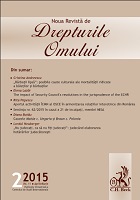„Bărbaţii lipsă”: posibile cauze culturale ale mortalităţii ridicate a băieţilor şi bărbaţilor
“Missing men”: possible cultural causes of the higher mortality of boys and men
Author(s): Cristina AndreescuSubject(s): Politics / Political Sciences
Published by: Centrul de Studii Internationale
Keywords: gender; mortality; health policy; cultural causes; missing men; breastfeeding; social networks; life expectancy
Summary/Abstract: Much has been made of the higher mortality rate of girls (relative to boys) in some Asian countries (China and India in particular); this has resulted in millions of “missing women”, to use a term coined by Amartya Sen, and is certainly a cause for serious concern. But few people seem to be concerned with the even higher mortality rate of boys (relative to girls) in developed countries. Moreover, the imbalance between the mortality of males and females becomes even stronger as they age. It is likely that the lack of interest in the high mortality of males stems from an implicit assumption that its causes must be biological. In this article I will try to show that culture is likely to also contribute to the differences between genders. I look at the sex differentials in mortality rates of children under 5 years old, adults between 18 and 60 years old, and the elderly (over 65 years old) to see what the patterns in mortality rates can say about the influence of gender. For each age group I review results in the scientific literature that lend support to one particular cultural cause contributing to sex differentials in mortality. Hence I look at the differences in parenting, and in particular breastfeeding, of children under 5 and the association between mortality and parenting style (and breastfeeding); at sex differences in the interaction of adults with the health system and their association with morbidity and mortality; at the sex differences in the social networks of the elderly and the association between social network quality and life expectancy. Finally, I make some small suggestions of how public policy should take into account these gender differences. I think that these results prove that men, in spite of their position of dominance in society, constitute a vulnerable group from the point of view of health policy. Therefore, these finding should inform public policy and lead to policies more adapted to the different needs of men versus women.
Journal: Noua Revistă de Drepturile Omului
- Issue Year: 11/2015
- Issue No: 2
- Page Range: 3-30
- Page Count: 28

